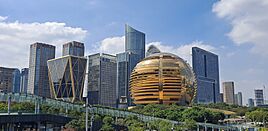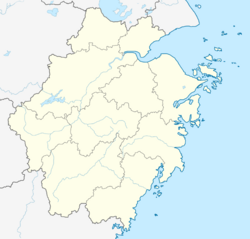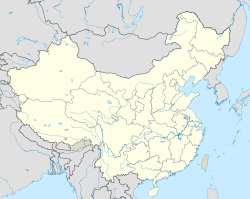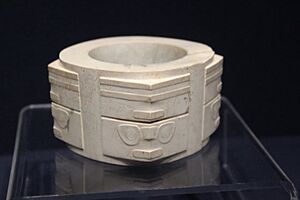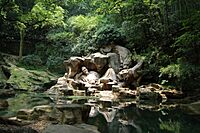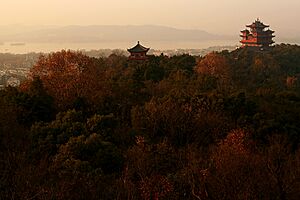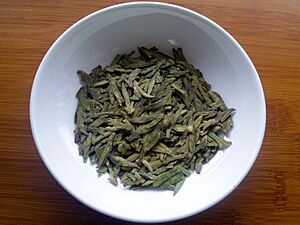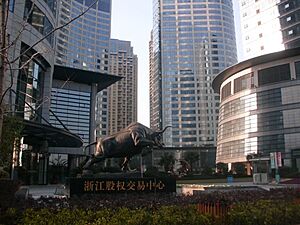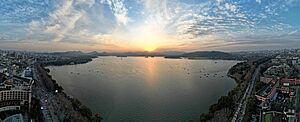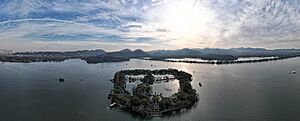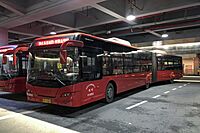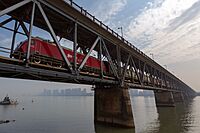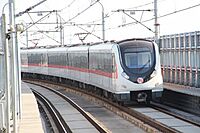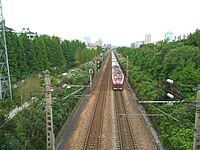Hangzhou facts for kids
Quick facts for kids
Hangzhou
杭州
Hangchow
|
||
|---|---|---|
|
Prefecture-level and sub-provincial city
|
||
|
From top, left to right: Qianjiang New City; the Chenghuang Pavilion; Lingyin Temple; Changqiao Park on the West Lake; aerial view of the Leifeng Pagoda; Xixi National Wetland Park; the Yue Fei Temple
|
||
|
||
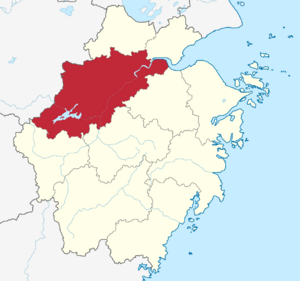
Location of Hangzhou City jurisdiction in Zhejiang
|
||
| Country | ||
| Province | Zhejiang | |
| Municipal seat | Shangcheng District | |
| Government | ||
| • Type | Sub-provincial city | |
| • Body | Hangzhou Municipal People's Congress | |
| Area | ||
| • Prefecture-level and sub-provincial city | 16,821.1 km2 (6,494.7 sq mi) | |
| • Urban | 8,259.9 km2 (3,189.2 sq mi) | |
| • Metro | 8,107.9 km2 (3,130.5 sq mi) | |
| Population
(2020 census)
|
||
| • Prefecture-level and sub-provincial city | 11,936,010 | |
| • Density | 709.5856/km2 (1,837.818/sq mi) | |
| • Urban | 10,711,238 | |
| • Urban density | 1,296.776/km2 (3,358.634/sq mi) | |
| • Metro | 13,035,329 | |
| • Metro density | 1,607.732/km2 (4,164.006/sq mi) | |
| • National rank | 5th | |
| Demonym(s) | Hangzhounese (杭州人, Hángzhōurén) |
|
| GDP | ||
| • Prefecture-level and sub-provincial city | CN¥ 1.875 trillion US$ 278.857 billion |
|
| • Per capita | CN¥ 175,587 US$ 27,223 |
|
| • Metro | CN¥ 3.970 trillion US$ 590.339 billion |
|
| Time zone | UTC+8 (China Standard) | |
| Postal code |
310000
|
|
| ISO 3166 code | CN-ZJ-01 | |
| Licence plate prefixes | 浙A | |
| Regional variety | Wu: Hangzhou dialect | |
| Website | Hangzhou.gov.cn | |
|
Camphor laurel (Cinnamomum camphora) City flower Sweet Osmanthus (Osmanthus fragrans) |
||
| Hangzhou | |||||||||||||||||||||||||
|---|---|---|---|---|---|---|---|---|---|---|---|---|---|---|---|---|---|---|---|---|---|---|---|---|---|

"Hangzhou" in Chinese characters
|
|||||||||||||||||||||||||
| Chinese | 杭州 | ||||||||||||||||||||||||
| Wu | ɦaŋ-tsei (Hangzhou dialect) | ||||||||||||||||||||||||
| Postal | Hangchow | ||||||||||||||||||||||||
| Literal meaning | "Hang Prefecture" | ||||||||||||||||||||||||
|
|||||||||||||||||||||||||
| Qiantang | |||||||||||||||||||||||||
| Simplified Chinese | 钱塘 | ||||||||||||||||||||||||
| Traditional Chinese | 錢塘 | ||||||||||||||||||||||||
|
|||||||||||||||||||||||||
Hangzhou is the capital city of Zhejiang province in China. It is located in the northeastern part of the province. The city sits at the top of Hangzhou Bay, which is between Shanghai and Ningbo.
Hangzhou is a very important city for business and technology. It is home to major global tech companies like Alibaba Group and NetEase. Many people who work in information technology come to Hangzhou. The city is also known for its beautiful West Lake, which is a UNESCO World Heritage Site.
In 2023, Hangzhou hosted the 2022 Asian Games, a big sports event. It was also the second Chinese city to host the Asian Para Games. In 2016, Hangzhou hosted the 11th G20 summit, where leaders from the world's biggest economies met.
Contents
Exploring Hangzhou's Past
How Hangzhou Began
People have lived in the area around Hangzhou for a very long time. The Hemudu culture, known for growing rice, lived about 7,000 years ago. The Liangzhu culture, famous for carving jade, lived here about 5,000 years ago.
Around 222 BC, Emperor Qin Shi Huang created Qiantang County in this area. This is why Hangzhou was also known as Qiantang and Wulin. In AD 589, Hangzhou became a major city with its own city wall. It also became the southern end of China's Grand Canal, a huge waterway that goes all the way to Beijing.
Hangzhou in the Tang Dynasty
During the Tang dynasty, a famous poet named Bai Juyi became the governor of Hangzhou. He saw that local farmers needed water from West Lake. The old dyke was broken, and the lake was drying up.
Bai Juyi ordered a new, stronger dyke to be built. This helped control the water flow and solved the drought problem for farmers. He also planted willow trees along the dyke, making it a beautiful landmark.
Hangzhou as a Capital City
Hangzhou is one of the Seven Ancient Capitals of China. From 907 to 978, it was the capital of the Wuyue Kingdom. It was called Xifu then. During this time, Hangzhou became an important cultural center. Its leaders supported arts and Buddhist temples.
In 1089, another famous poet and governor, Su Shi, built a long causeway across West Lake. He used 200,000 workers to build this 2.8 km (1.7 miles) long path from mud taken from the lake.
In 1132, Hangzhou became the new capital of the Southern Song dynasty. This happened after northern China was taken over by the Jurchens. The city was known as Lin'an during this time. It grew very large and was a major center for trade and government. Many famous thinkers and poets lived here.
Historians believe Hangzhou was the largest city in the world from 1180 to 1315. It had a huge population, possibly over a million people. Because of its many wooden buildings, fires were a big problem. The city created a special system with watchtowers and soldiers to fight fires.
Hangzhou Under Mongol Rule
In 1276, the Mongol armies of Kublai Khan captured Hangzhou. The Mongols made Dadu (modern-day Beijing) their capital. But Hangzhou remained an important city for trade and management in the south.
-
"Moon over the Peaceful Lake in Autumn", one of the Ten Scenes of the Xi Hu
-
Dreaming of the Tiger Spring, the burial place of monk Jigong
Travelers' Tales of Hangzhou
During the Mongol rule, many foreign visitors came to China. They described Hangzhou as one of the greatest cities in the world. The Venetian merchant Marco Polo supposedly visited Hangzhou in the late 1200s. He wrote that the city was "greater than any in the world."
In the 1300s, the Moroccan traveler Ibn Battuta also visited Hangzhou. He called it "the biggest city I have ever seen on the face of the earth." He was amazed by the beautiful lake and the many Chinese wooden ships with colorful sails.
Hangzhou in Modern Times
Hangzhou remained an important port for a long time. However, its harbor slowly filled with dirt during the Ming dynasty.
In the 1800s, the city was damaged during the Taiping Heavenly Kingdom rebellion. From 1937 to 1945, Japan occupied the city during the Second Sino-Japanese War. In 1949, the People's Liberation Army took control of Hangzhou.
After China's economic reforms began in 1978, Hangzhou grew very quickly. Today, it is one of China's most successful big cities.
Hangzhou's Location and Weather
Where is Hangzhou Located?

Hangzhou is in the northwestern part of Zhejiang province. It is at the southern end of the Grand Canal of China. The city's area stretches west into mountains and east to the coast near Hangzhou Bay. The city center is built around the eastern and northern sides of the West Lake. It is just north of the Qiantang River.
The Qiantang River is the largest river in Zhejiang. Every year, a huge tidal bore happens here. It is called "the Biggest Tide in the World." This giant wave races up the river and can reach up to 12 meters (39 feet) high!
What is Hangzhou's Climate Like?
| Weather chart for Hangzhou | |||||||||||||||||||||||||||||||||||||||||||||||
|---|---|---|---|---|---|---|---|---|---|---|---|---|---|---|---|---|---|---|---|---|---|---|---|---|---|---|---|---|---|---|---|---|---|---|---|---|---|---|---|---|---|---|---|---|---|---|---|
| J | F | M | A | M | J | J | A | S | O | N | D | ||||||||||||||||||||||||||||||||||||
|
75
8
1
|
91
10
3
|
130
14
6
|
125
21
12
|
153
26
17
|
223
29
21
|
153
33
25
|
154
33
25
|
150
28
21
|
79
23
15
|
65
17
9
|
53
11
3
|
||||||||||||||||||||||||||||||||||||
| temperatures in °C precipitation totals in mm source: The National Centers for Environmental Information (NCEI) |
|||||||||||||||||||||||||||||||||||||||||||||||
|
Imperial conversion
|
|||||||||||||||||||||||||||||||||||||||||||||||
Hangzhou has a humid subtropical climate. This means it has four clear seasons. Summers are long, very hot, and humid. Winters are chilly, cloudy, and drier, but sometimes it snows.
The average yearly temperature is 17.0°C (62.6°F). January is the coldest month, averaging 5°C (41°F). July is the hottest, averaging 29.3°C (84.7°F). The city gets about 1438 mm (56.6 inches) of rain each year. It is affected by the "plum rains" in June. Sometimes, typhoon storms affect the area in late summer. They bring strong winds and heavy rains.
| Climate data for Hangzhou (1991–2020 normals, extremes 1951–present) | |||||||||||||
|---|---|---|---|---|---|---|---|---|---|---|---|---|---|
| Month | Jan | Feb | Mar | Apr | May | Jun | Jul | Aug | Sep | Oct | Nov | Dec | Year |
| Record high °C (°F) | 25.4 (77.7) |
28.5 (83.3) |
32.8 (91.0) |
35.1 (95.2) |
37.6 (99.7) |
39.7 (103.5) |
41.3 (106.3) |
41.9 (107.4) |
38.8 (101.8) |
38.4 (101.1) |
31.2 (88.2) |
26.5 (79.7) |
41.9 (107.4) |
| Mean maximum °C (°F) | 17.4 (63.3) |
21.3 (70.3) |
25.7 (78.3) |
30.6 (87.1) |
33.8 (92.8) |
35.3 (95.5) |
37.9 (100.2) |
37.3 (99.1) |
34.4 (93.9) |
30.3 (86.5) |
25.1 (77.2) |
19.5 (67.1) |
38.2 (100.8) |
| Mean daily maximum °C (°F) | 8.6 (47.5) |
11.1 (52.0) |
15.9 (60.6) |
22.1 (71.8) |
26.9 (80.4) |
29.2 (84.6) |
34.0 (93.2) |
33.4 (92.1) |
28.7 (83.7) |
23.6 (74.5) |
17.7 (63.9) |
11.3 (52.3) |
21.9 (71.4) |
| Daily mean °C (°F) | 5.0 (41.0) |
7.0 (44.6) |
11.1 (52.0) |
17.0 (62.6) |
22.0 (71.6) |
25.0 (77.0) |
29.3 (84.7) |
28.7 (83.7) |
24.5 (76.1) |
19.3 (66.7) |
13.3 (55.9) |
7.4 (45.3) |
17.5 (63.4) |
| Mean daily minimum °C (°F) | 2.2 (36.0) |
4.0 (39.2) |
7.6 (45.7) |
13.0 (55.4) |
18.0 (64.4) |
21.8 (71.2) |
25.6 (78.1) |
25.4 (77.7) |
21.4 (70.5) |
15.8 (60.4) |
10.0 (50.0) |
4.3 (39.7) |
14.1 (57.4) |
| Mean minimum °C (°F) | −3.9 (25.0) |
−2.3 (27.9) |
0.8 (33.4) |
5.8 (42.4) |
12.1 (53.8) |
16.9 (62.4) |
21.5 (70.7) |
21.4 (70.5) |
16.0 (60.8) |
9.0 (48.2) |
2.5 (36.5) |
−2.8 (27.0) |
−4.6 (23.7) |
| Record low °C (°F) | −8.6 (16.5) |
−9.6 (14.7) |
−3.5 (25.7) |
0.2 (32.4) |
7.3 (45.1) |
12.8 (55.0) |
17.3 (63.1) |
18.2 (64.8) |
12.0 (53.6) |
1.0 (33.8) |
−3.6 (25.5) |
−8.4 (16.9) |
−9.6 (14.7) |
| Average precipitation mm (inches) | 93.3 (3.67) |
89.9 (3.54) |
135.7 (5.34) |
116.8 (4.60) |
126.8 (4.99) |
258.2 (10.17) |
167.5 (6.59) |
176.8 (6.96) |
113.3 (4.46) |
74.1 (2.92) |
75.2 (2.96) |
64.2 (2.53) |
1,491.8 (58.73) |
| Average precipitation days (≥ 0.1 mm) | 12.4 | 11.7 | 14.9 | 13.8 | 13.3 | 15.4 | 12.2 | 13.7 | 11.2 | 8.1 | 10.6 | 9.7 | 147 |
| Average snowy days | 4.2 | 2.8 | 0.8 | 0.1 | 0 | 0 | 0 | 0 | 0 | 0 | 0.2 | 1.4 | 9.5 |
| Average relative humidity (%) | 74 | 73 | 72 | 70 | 71 | 79 | 73 | 75 | 76 | 73 | 75 | 72 | 74 |
| Mean monthly sunshine hours | 95.6 | 97.7 | 120.4 | 144.7 | 158.9 | 120.0 | 204.6 | 187.9 | 139.9 | 141.6 | 118.9 | 112.6 | 1,642.8 |
| Percent possible sunshine | 30 | 31 | 32 | 37 | 38 | 28 | 48 | 46 | 38 | 40 | 38 | 36 | 37 |
| Source: China Meteorological Administration | |||||||||||||
People and Culture of Hangzhou
How Many People Live in Hangzhou?
| Historical population | ||
|---|---|---|
| Year | Pop. | ±% |
| 2000 | 6,878,722 | — |
| 2010 | 8,700,373 | +26.5% |
| 2020 | 11,936,010 | +37.2% |
| 2022 | 12,376,000 | +3.7% |
| 2023 | 12,522,000 | +1.2% |
| sources: (census dates, administrative division)
and (yearend est.) 2023年杭州市人口主要数据公报: (website only visible inside China) 2023年末全市常住人口中,男性为652.1万人,占总人口的52.1%;女性为600.1万人,占总人口 的47.9%。性别比(以女性为100,男性对女性的比例)为108.7。 |
||
As of 2023, Hangzhou had about 12.5 million people living there. Most of them, about 84%, live in the city's urban areas. The larger Hangzhou metropolitan area, which includes nearby cities, is home to over 29 million people.
People in Hangzhou live long lives! The average life expectancy for registered residents is over 83 years. This is one of the highest in China.
Religions in Hangzhou
Hangzhou has a long history of different religions. In the 1800s, it was known as a strong center for Islam in China. There are several mosques in the city, like the New Hangzhou Great Mosque and the Phoenix Mosque.
Hangzhou was also an important place for Chinese Jews centuries ago. The city also has old Catholic churches, like the Immaculate Conception Cathedral of Hangzhou, which is 400 years old.
There are many temples near the West Lake. Lingyin Temple is the oldest and most famous Buddhist temple in Hangzhou, dating back about 1,700 years. Yuefei Temple was built in 1221 to honor General Yue Fei. Other famous temples include Jingci Temple, Baochu Pagoda, Leifeng Pagoda, Liuhe Pagoda, and Hupao Temple.
Hangzhou's Unique Language and Arts
The local people of Hangzhou speak the Hangzhou dialect. This is a special type of Wu Chinese language. It is different from other dialects in the region. While most people also speak Mandarin, the Hangzhou dialect is still used by many.
Hangzhou has several museums. These include the China National Silk Museum, which is the largest silk museum in the world. There is also the China National Tea Museum and the Zhejiang Provincial Museum.
The city is also known for its arts. Many theaters host Yue opera shows. There are big performances about Hangzhou's history and culture, like "Impression West Lake." Hangzhou is home to the China Academy of Art, where many famous painters studied. The local government supports arts like silk production, umbrella making, and Chinese folding fans.
Delicious Food from Hangzhou
Hangzhou's food is a key part of Zhejiang cuisine. This is one of China's eight main cooking styles. Hangzhou dishes are known for being "fresh, tender, soft, and smooth, with a mellow fragrance." They are often a bit sweeter than savory.
Some famous Hangzhou dishes include:
- West Lake Vinegar Fish
- Dongpo Pork
- Longjing Shrimp
- Beggar's Chicken
- Pian Er Chuan Noodles
Longjing tea is the most famous green tea in China. The best Longjing tea comes from around the West Lake. Tea is a very important part of Hangzhou's culture and economy.
Hangzhou's Economy and Business
A Growing Economic Hub

Hangzhou's economy has grown very quickly since 1992. It is a major industrial city with many different businesses. These include light industry, farming, and textiles. It is also a key place for manufacturing and moving goods along China's coast.
The city is a big center for e-commerce and technology. Companies like Alibaba Group, NetEase, Ant Group, Geely, and Hikvision have their main offices here. Many computer programmers and business people come to Hangzhou for work.
Hangzhou is considered one of the "Chinese Cities of Opportunity." It ranks high globally for its economic growth potential. It also has many Fortune Global 500 company headquarters, more than most cities in the world.
What Industries Thrive in Hangzhou?
Hangzhou has developed many new industries. These include:
- Medicine
- Information technology
- Heavy equipment
- Car parts
- Home appliances
- Electronics
- Telecommunications
- Chemicals
- Food processing
The city focuses on "1 + 6" industrial groups. The "1" is the digital economy, which is very important. The "6" includes cultural and creative businesses, finance, tourism, fashion manufacturing, and high-tech equipment making. The digital and creative sectors are leading Hangzhou's economic growth.
Tourism in Hangzhou
Tourism is a very important part of Hangzhou's economy. The city actively promotes itself to visitors. In 2013, the Hangzhou Tourism Commission started a "Modern Marco Polo" campaign. They chose the first foreign tourism ambassador for the city.
Exploring Hangzhou's Cityscape
Beautiful Parks and Resorts
Hangzhou has grown a lot, but it still keeps its historical beauty and natural environment. Tourism is a big part of its economy. The city has many tall buildings, ranking among the top cities in the world for skyscrapers.
The most famous sight is West Lake, a UNESCO World Heritage Site. It covers a large area and includes many historic and beautiful places. Around the lake, you can find old pagodas, cultural sites, and lovely hills. There are two causeways that cross the lake. The area near the lake is also known for longjing tea fields.
The Grand Canal in Hangzhou is also a World Heritage Site. It was built in 610 AD. You can visit its historical sites using the Hangzhou Metro. The West Lake Cultural Square has several famous buildings. These include the Zhejiang Natural History Museum and the Zhejiang Global Center, a tall building in the city.
The Xixi National Wetland Park helps protect the wetland environment. It has fish ponds and reed beds and is home to many birds. It also has a temple and old rural houses. Qiandao Lake is a man-made lake with many islands. The Hangzhou Botanical Garden and the Hangzhou Zoo are also popular places to visit.



Getting Around Hangzhou
Public Transportation Options
Hangzhou has a good public transport system. It has many buses, including electric ones. The city also has trolleybuses. There used to be a large bus rapid transit (BRT) network, but most routes have changed to regular bus lines.
Taxis are also common. In 2011, Hangzhou started using electric taxis. The city plans to have many more electric taxis in the future.
Long-distance bus stations offer frequent services to nearby cities and towns.
Hangzhou Metro is the city's subway system. As of mid-2021, it has over 323 km (200 miles) of lines. The Metro system is still growing, with plans for 15 lines. This expansion will help people get around easily, especially for big events like the Asian Games. Line 1 opened in 2012, connecting the city center with suburbs.
Biking in Hangzhou
Bicycles and electric scooters are very popular in Hangzhou. Many major streets have special bike lanes. Hangzhou has a large public bike rental system. You can rent bikes using a special card or a phone app. Rides under 60 minutes are usually free.
Train Travel in Hangzhou
Hangzhou is a major train hub in China. The main station is Hangzhou East station. It has many platforms for high-speed trains to cities like Shanghai, Nanjing, and Ningbo. You can get to Shanghai in about 50 minutes on a non-stop high-speed train.
A second high-speed rail line and a new station, Hangzhou West, opened in 2022. Direct trains connect Hangzhou to over 50 major cities across China.
Air and Sea Travel
Hangzhou Xiaoshan International Airport serves Hangzhou. It has direct flights to many international places like Thailand, Japan, and the United States. It also has many flights within China. The airport is one of the busiest in China.
The Port of Hangzhou is a river port. It handles over 100 million tons of cargo each year.
Learning and Research in Hangzhou
Hangzhou is a big center for education and science in China. It ranks high globally for scientific research. The city has many universities. The most famous is Zhejiang University, which is one of the top public research universities in the world.
Hangzhou has many college towns, like Xiasha and Xiaoheshan. Some other universities in Hangzhou include:
- China Academy of Art
- Hangzhou Normal University
- Westlake University
- Zhejiang Sci-Tech University
There are also many excellent high schools in Hangzhou, both public and private.
Hangzhou's Sister Cities
Hangzhou has "sister city" relationships with many cities around the world. This means they work together on cultural and economic projects.
Famous Sayings About Hangzhou
There are some old Chinese sayings that show how special Hangzhou is:
"There is Heaven above, and Suzhou and Hangzhou below." (上有天堂,下有苏杭) This saying means that Hangzhou and Suzhou are as beautiful as heaven on Earth. Marco Polo even called Hangzhou "the city of heaven."
"Be born in Suzhou, live in Hangzhou, eat in Guangzhou, die in Liuzhou." (生在苏州,活在杭州,吃在广州,死在柳州) This saying means:
- Suzhou is known for its beautiful and educated people.
- Hangzhou is famous for its amazing scenery.
- Guangzhou is known for its delicious food.
- Liuzhou is known for its special wooden coffins, which were thought to preserve bodies well.
Images for kids
-
Gilt silver Hōkyōintō unearthed from Leifeng Pagoda Site, Zhejiang Provincial Museum
See also
 In Spanish: Hangzhou para niños
In Spanish: Hangzhou para niños


